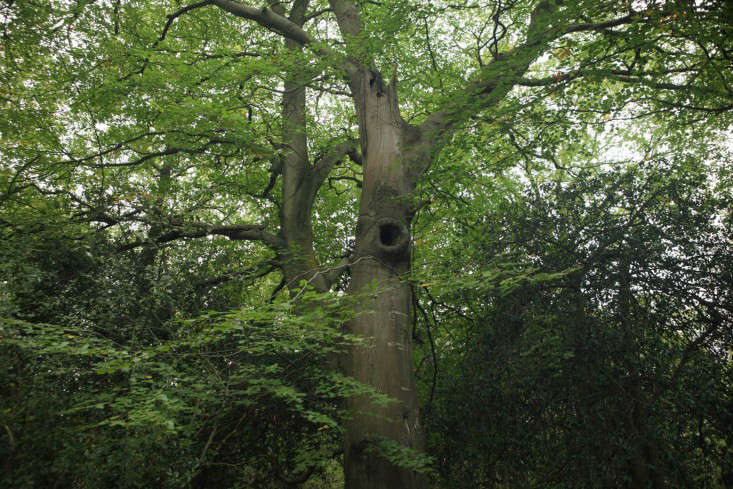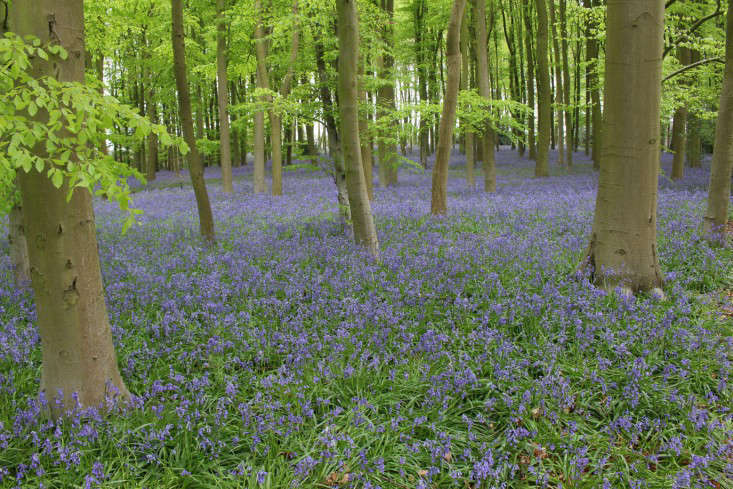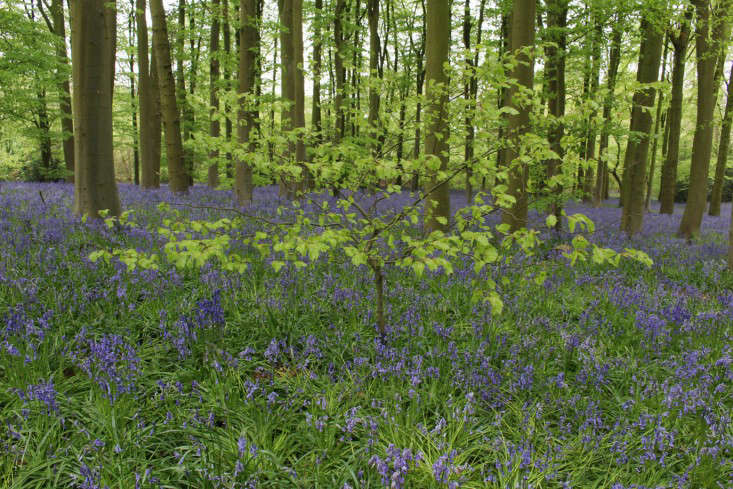European beech (Fagus sylvatica): “The Chameleon”
As a tall and graceful tree, beech can live to half a millennium. Its good looks can be adapted to a smaller garden as a hedge and it mingles well with other natives as a wilder mixed barrier. Informal or formal, a pleached beech could be the way, for a high hedge on stilts.
Photography by Kendra Wilson, except where noted.
Above: A beech column is one of the simplest topiary shapes, created here by Arne Maynard at Cottesbrooke Hall. The different stages of autumn play out on this single specimen, making it a great-value structural piece in a formal or semi-formal setting. A straight or curvy hedge is also a good showcase for the seasons.
See Maynard’s garden at Garden Designer Visit: Arne Maynard at Home in Wales.
Above: Weeping beech is a lovely thing for gardens with a lot of space, its yellow-orange-green tints waving around in fall. It is one of several variations that suit this smooth, gray-barked tree. Copper beech has dark red, almost black foliage and has been used to great effect as contrasting hedging or as beech “platforms.” Spaced through grass, blocks of copper beach provide backbone. American beech (Fagus grandifolia) is less often grown, being slower and less pollution-tolerant.
For beech platforms in a designed landscape, see A Modern Garden in a Medieval Setting.
Above: Hornbeam is a good alternative to beech if excellent drainage cannot be guaranteed. For the non-expert, they are alike enough, with beech more smooth around the edges. Shown here: hornbeam left, beech right.
See more ways to use hornbeams in a landscape at 10 Garden Ideas to Steal from Old Wollerton Hall.
Above: Classic woodland in the UK includes beech, oak, and birch. This ancient beech is part of the Five Hundred Acre Wood in East Sussex, immortalized by A.A. Milne as the 100-Acre Wood. The holey trunk above would make a fine dwelling for Owl. Photograph by Jim Powell.
Cheat Sheet
- Beech has distinct identities either as a very tall tree or an agreeable hedge.
- A beech hedge that is trimmed will retain its foliage in winter, creating an opaque screen.
- Plant small beech whips about a foot apart; they will establish better than larger specimens.
Keep it Alive
- Beech likes a well-drained soil; if you can’t provide that, plant hornbeam.
- Despite its eventual height, beech is notoriously shallow-rooting and should not be planted as a tree close to the house.
- American beech can withstand a hotter climate than European; both are suitable for zones 4-9.
Above: The floor of a beech wood is typified by thick leaf mold and the scrunch of beech masts. Or rather, their husks, since the small nuts are whisked away by the more alert: squirrels and mice. It is an acid mixture and not conducive to an understory except in the case of certain types of plant, including bluebells. Photograph by Jim Powell.
Above: A bluebell wood is so-called because it consists of two monocultures: beech and Hyacinthoides non-scripta. In England, it is (in theory) a remarkably simple way of planting up five acres.
Above: In April when new leaves on beech are just beginning to unscroll, there is enough sunlight to encourage a carpet of bluebells. Sun comes in at a slanted angle and the ground is still moist. Six weeks later the conditions would not work: too dry and dark.
Further reading:
- Beech or hornbeam? For help choosing, see Field Guide: Hornbeam.
- For further field guides on autumn trees: Field Guide: Apple Trees.
- Topiary is an Arne Maynard specialty: see how he does it at home: Designer Visit: Arne Maynard at Home in Wales.
N.B.: Wondering what the right tree is for your setting? If so, our Garden Design 101 guides can help:
- See more on trees at Copper Beech Tree 101, Hornbeam Tree 101, and Hawthorne Tree 101.
Finally, get more ideas on how to successfully plant, grow, and care for european beech tree with our European Beech Tree: A Field Guide.
Additionally, get more ideas on how to successfully plant, grow, and care for copper beech tree with our Copper Beech Tree: A Field Guide.
Interested in other types of trees? Get more ideas on how to plant, grow, and care for various trees (specimen, deciduous, evergreen) with our Trees: A Field Guide.















Have a Question or Comment About This Post?
Join the conversation